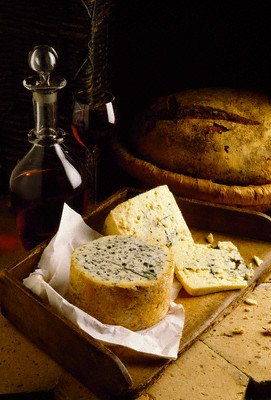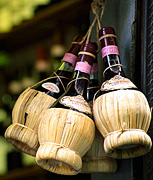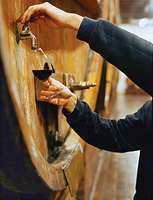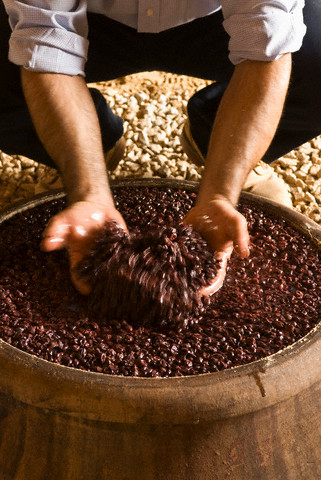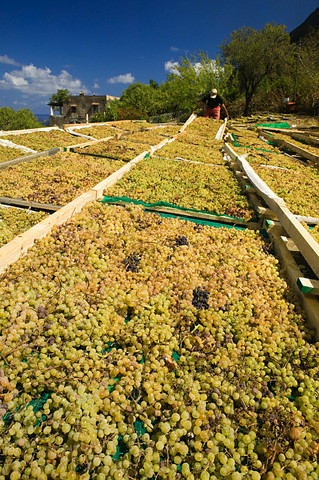

|
Trapani Wines: Marsala Popular for cooking “fortified wines” were those with Brandy or ethyl alcohol to help them weather ocean journeys “solera” tradition: After the first keg is filled, the coinciding flavors of succeeding years are placed on top. Then, the wine taken from the the oldest keg is invigorated with that of the keg above and the cycle continues in this way preserving continence of flavor and in essence, including a bit of the very first vintage in every bottle. Grillo: aka Riddu, white grape variety used in Marsala & other Sicilian wines (Monreale, Alcamo, Contea di Sclafani, Delia Nivolelli). Possibly came to Sicily from Puglia (although its origin is not clear). Was widely found in Trapani region by 1897. Today it can be grown around Sicily as well as the Aeolian Islands. Bianco d’Alcamo or Alcamo (DOC) One of the hallmarks of Sicilian wine production Great with seafood. Various wines use various varieties. Delia Nivolelli (DOC) is a product of the innovations implemented in the Trapani region in the 1980’s after the uncertain wine market made it clear the wine industry needed a new taste if it were to survive. Created from 13 different wines based on both indigenous and foreign varietals. Wines belonging to the Erice (DOC) must recognize indigenous varietals like Catarratto, Nero d’Avola, Grillo, Insolia, Frappato, Perricone, and Zibibbo, but can also use non-indigenous varietals like Chardonnay, Sauvignon, Merlot, Syrah and Cabernet Sauvignon. Salaparuta is a town with a vibrant history: founded by Arabs, re-founded around a medieval castle in the 15th century, and rebuilt after 1968 Belice earthquake. Mostly agricultural area with grapes as main product. With an abundance of vineyards, the Salaparuta (DOC) has great wine-producing quantity potential, but with few vintners in the area, only produces a fraction of its wine potential annually. As with other regions, Salaparuta (DOC) (awarded in 2006) is a combination of native varietals (Nero d’Avola, Catarratto, Inzolia and Grillo) and newly introduced ones (Cabernet Sauvignon, Syrah, Merlot and Chardonnay). Moscato di Pantelleria (DOC), according to legend, is the wine of the gods. It claimed this title after the goddess Tanit lured Apollo and won his love by switching his goblet of ambrosia for this wine. Wasn’t known outside of Pantelleria until 1883 when the Rallo wine house added it to its list of Marsalas. A historically highly praised wine. Received it’s DOC in 1971, making it the third Italian wine to receive this classification. Food pairings: Cannoli con ricotta, Strawberries drizzled with Basalmic vinegar from Reggio Emilia, carrot cake. Agrigento Wines: Contea di Sclafani (DOC) (wine-growing land region divided between Agrigento & Caltanissetta provinces) Always been considered an ideal viticultural climate Vitners finally owned land in 1970’s and since they’ve expanded in two opposite directions: one being the pursuit of everything “new” to Sicily (from varietals like Chardonnay, Syrah, Sauvignon, etc, to experimental wine-producing techniques) and the second being vinifying traditional varietals separately to maintain the integrity of their individual characteristics. Greek and Roman relics found in the area connect the area of Menfi (and ancient city Inycon) to the ancient wine trade. Depsite its historic importance in the wine trade, Menfi didn’t receive it’s DOC rating until 1995. Menfi (DOC) was established after careful research had been conducted by the Regional Vine and Wine Institute of Palermo with the University of Milan and the Provincial Agrarian Institute of San Michele all'Adige (Trento). Both traditional varietals, as well as those non-indigenous, are important in this region’s vinification. Founded by Arab emit, Zabut, this town still has a Saracen neighborhood among other Arabic remnants. Archaeological remnants discovered nearby, however, imply that the Greeks were probably the ones to bring grapes to the area. Sambuca di Sicilia (DOC) wines have always been high quality (highly desired long before DOC ratings were ever created). Awarding of DOC status allowed these successful vintners to elaborate with international wines like Chardonnay and Cabernet Sauvignon. Settled by Arabs around 827 A.D., this fertile river valley has remnants of wine production dating back to that period. Santa Margherita di Belice (DOC) received its DOC in 1994. Include “rosso” and “bianco” groups, in addition to five other local wines made from red and white grapes. Sciacca (DOC) region grows all kinds of varietals well. In addition to red, white, and rosè wines, the area produces 7 other wines that range from using indigenous varietals to imported ones. Riserva Rayana is one of the most particular wines of Sciacca (DOC). Made from Catarratto Lucido and Inzolfa, in a restricted part of Sciacca, it is aged 2 years (minimum 1 in wooden barrels). It is characterized by a golden color, with an intense, enduring fragrance and full taste. Caltanissetta Wines: Contea di Sclafani (DOC) (wine-growing land region divided between Agrigento & Caltanissetta provinces) Always been considered an ideal viticultural climate Vitners finally owned land in 1970’s and since they’ve expanded in two opposite directions: one being the pursuit of everything “new” to Sicily (from varietals like Chardonnay, Syrah, Sauvignon, etc, to experimental wine-producing techniques) and the second being vinifying traditional varietals separately to maintain the integrity of their individual characteristics. Historically marginal in the production of wine, Riesi (DOC) takes it’s name from Latin meaning “uncultivated land”. In recent years, a rapid spurt of vineyards in the area has resulted in the inclusion of Riesi in the Cerasuolo di Vittoria (DOC). It achieved its own DOC based on the character of their wines from Frappato, Calabrese and Ansonica to imported ones (like Chardonnay and Cabernet Sauvignon). Catania Wines: Among the oldest wine-growing areas on Sicily (since cira 5th century B.C.), the Etna slopes covered in vines were even written about by poet Theocritus. Until the plague of grape phylloxera (a tiny bug related to the aphid that feeds on the roots of grapevines) at the beginning of the last century, Catania province was the leading region of Sicily covered by the most vineyards. Etna eruptions and difficult, sandy terrain have also hindered output in the region, but never distorted the quality of wines produced by the slopes’ vines. Etna (DOC) district wines were first to receive DOC classification in 1968. This outstanding wines are made using the ancient Carricante and Nerello Mascalese varieties, which may seem feeble, but are big producers with richly nuanced flavors. Climate for growing these resembles more of a desert than the Mediterranean. Messina Wines: Faro (DOC) comes from the vineyards of the Straits of Messina. Area was an ancient wine-growing and wine-trading hubbub for the natives & Phoenicians. Julius Caesar celebrated his third term with an abundance of Mamertino wine from Messina. Viticulture in Messina has been a rollercoaster since the Arab conquest of Sicily, being also affected by the grape phylloxera insect plague. Although wine production in Messina seemed doomed at times, the shift to focusing on quality production has been its savior (as with many other regions of Sicily). Today, Faro, a superior red wine is a standing example of the quality of wines from Messina and is world renown. Although associated with Messina, Mamertino di Milazzo (DOC) is thought to have grown around the base of Etna and near Agrigento long before any outsiders made contact with natives of Sicily. A popular wine in the ancient world (Julius Caesar, Pliny the Elder, Martial). Four varieties exist today: white, red, Calabrese/Nero d’Avola and Grillo-Ansonica. Malvasia delle Lipari (DOC) is a very ancient wine, thought to pre-date the Greeks. Comes in three forms: One to accompany meals, one to accompany desserts, and one liqueur. Local legend tells that a farmer taking the wine to his father and the priest was stopped by the Arab governor and questioned what he was carrying. The farmer said it was mallow juice and prayed “malva sia” (let it be mallow juice)—the wine was transformed to juice as the Arab governor tasted it. Rare product; produced in very small quantities. Made using a thousand year old method. (similar to Moscato di Pantelleria); considered a straw wine because of the drying of grapes on straw mats under the sun. Palermo Wines: Contessa Entellina (DOC) known for its wine since ancient times has strong reds; aged more than a typical Southern Italian red. In addition to ideal climate, have an ideal altitude too. Their innovations include introducing the use of “foreign” vines like Pinot Noir, Cabernet, Chardonnay and Sauvignon. Legend holds that the wine of Monreale was responsible for stopping Hasdrubal, the Carthaginian general, and his troops from defeating Roman consul Cecilio Metello and conquering Palermo in 251 B.C. Monreale (DOC) wasn’t awarded its DOC until 2000 after a major restructuring of the vineyards. The restructuring included the introduction of Cabernet Sauvignon, Syrah and Merlot, in addition to the traditional varieties of Perricone and Nero d'Avola. Ragusa Wines: Cerasuolo di Vittoria (DOCG): Only DOCG wine in Sicily Made its public debut in at the first Exhibition Market of Sienna in 1933 Made from red Frappato grapes Recommended consumption is well aged as an aperitif. Vittoria (DOC) achieved DOC rating shortly after Cerasuolo for both red and white wines produced in area with Ansonica, Nero d’Avola and Frappato grapes. Vittoria (DOC) wines are considered more approachable than Cerasuolo. Siracusa Wines: Eloro (DOC): Bursting with ancient Greek remnants and Baroque relics, the southern most tip of Sicily is also known for it’s full-bodied reds using local varietals Frappato, Pignatello, and Nero d’Avola. Traditionally used to fill out thin wines from the mainland. An experimental creation, Moscato di Noto (DOC) was created to be consumed young, without required aging, and to be finer and more flavourful than the Moscato di Siracusa. It was so revolutionary, that the Moscato di Noto beat out the Moscato di Siracusa to debut in 1933 at the first Exhibition Market of Italian Typical Wines. It is produced in very limited quantities, which is unfortunate since it carries nicely the flavors of the land and deserves to be a part of wine cellars worldwide. Moscato di Siracusa (DOC) is one of several wines in Sicily competing for the title of the most ancient. Unfortunately, it is no longer produced. Most likely due to the success of the Moscato di Noto (DOC) that was created to improve upon the inconsistencies of Moscato di Sicracusa. |
Jump to:
|
About Sicily | Travel Sicily | Contact Us | Home
Sicilybella.com - Copyright 2012. All rights reserved. Disclaimer: Prices subject to change without notice.
May contain technical inaccuracies and typographical errors.
These pages may be updated from time to time.

